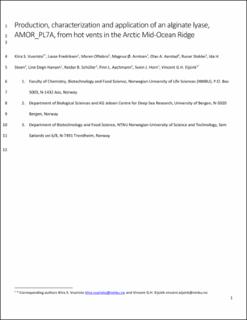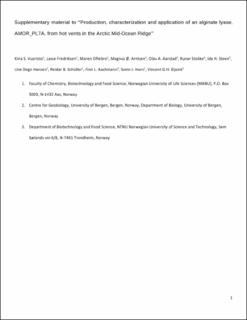| dc.contributor.author | Vuoristo, Kiira | |
| dc.contributor.author | Fredriksen, Lasse | |
| dc.contributor.author | Oftebro, Maren | |
| dc.contributor.author | Arntzen, Magnus Øverlie | |
| dc.contributor.author | Aarstad, Olav Andreas | |
| dc.contributor.author | Stokke, Runar | |
| dc.contributor.author | Steen, Ida Helene | |
| dc.contributor.author | Hansen, Line Degn | |
| dc.contributor.author | Schüller, Reidar Barfod | |
| dc.contributor.author | Aachmann, Finn Lillelund | |
| dc.contributor.author | Horn, Svein Jarle | |
| dc.contributor.author | Eijsink, Vincent | |
| dc.date.accessioned | 2021-04-20T12:33:09Z | |
| dc.date.available | 2021-04-20T12:33:09Z | |
| dc.date.created | 2019-06-14T08:47:02Z | |
| dc.date.issued | 2019 | |
| dc.Published | Journal of Agricultural and Food Chemistry. 2019, 67 (10), 2936-2945. | |
| dc.identifier.issn | 0021-8561 | |
| dc.identifier.uri | https://hdl.handle.net/11250/2738684 | |
| dc.description.abstract | Enzymatic depolymerization of seaweed polysaccharides is gaining interest for the production of functional oligosaccharides and fermentable sugars. We describe a thermostable alginate lyase belonging to Polysaccharide Lyase family 7 (PL7), which can be used to degrade brown seaweed, Saccharina latissima, at conditions also suitable for a commercial cellulase cocktail (Cellic CTec2). This enzyme, AMOR_PL7A, is a β-d-mannuronate specific (EC 4.2.2.3) endoacting alginate lyase, which degrades alginate and poly mannuronate within a broad range of pH, temperature and salinity. At 65 °C and pH 6.0, its Km and kcat values for sodium alginate are 0.51 ± 0.09 mg/mL and 7.8 ± 0.3 s–1 respectively. Degradation of seaweed with blends of Cellic CTec2 and AMOR_PL7A at 55 °C in seawater showed that the lyase efficiently reduces viscosity and increases glucose solublization. Thus, AMOR_PL7A may be useful in development of efficient protocols for enzymatic seaweed processing. | en_US |
| dc.language.iso | eng | en_US |
| dc.publisher | ACS | en_US |
| dc.title | Production, characterization, and application of an alginate lyase, AMOR_PL7A, from hot vents in the Arctic mid-ocean ridge | en_US |
| dc.type | Journal article | en_US |
| dc.type | Peer reviewed | en_US |
| dc.description.version | acceptedVersion | en_US |
| dc.rights.holder | Copyright 2019 American Chemical Society | en_US |
| cristin.ispublished | true | |
| cristin.fulltext | postprint | |
| cristin.fulltext | postprint | |
| cristin.fulltext | postprint | |
| cristin.qualitycode | 2 | |
| dc.identifier.doi | 10.1021/acs.jafc.8b07190 | |
| dc.identifier.cristin | 1704834 | |
| dc.source.journal | Journal of Agricultural and Food Chemistry | en_US |
| dc.source.40 | 67 | |
| dc.source.14 | 10 | |
| dc.source.pagenumber | 2936-2945 | en_US |
| dc.relation.project | Norges forskningsråd: 239003 | en_US |
| dc.relation.project | Norges forskningsråd: 270038 | en_US |
| dc.relation.project | Norges forskningsråd: 237841 | en_US |
| dc.relation.project | Norges forskningsråd: 226247 | en_US |
| dc.relation.project | Norges forskningsråd: 229003 | en_US |
| dc.identifier.citation | Journal of Agricultural and Food Chemistry. 2019, 67 (10), 2936–2945 | en_US |
| dc.source.volume | 67 | en_US |
| dc.source.issue | 10 | en_US |

